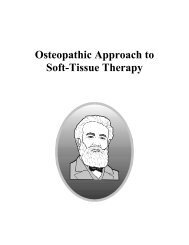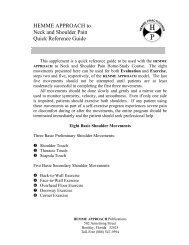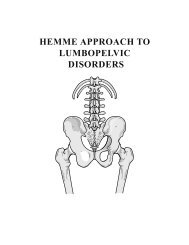HEMME APPROACH TO SOFT-TISSUE THERAPY
HEMME APPROACH TO SOFT-TISSUE THERAPY
HEMME APPROACH TO SOFT-TISSUE THERAPY
You also want an ePaper? Increase the reach of your titles
YUMPU automatically turns print PDFs into web optimized ePapers that Google loves.
injuries. Factors that contribute to soft-tissue impairments are fatigue,<br />
psychological stress, environmental factors, and somatic or visceral reflexes.<br />
Some impairments develop without apparent cause (idiopathic conditions),<br />
while others are caused by inappropriate treatment (iatrogenic disorders).<br />
Most soft-tissue impairments are caused by trauma and the most common<br />
sequel is tissue damage, spasm, edema, pain, and ultimately myofibrosis.<br />
The onset of soft-tissue impairments can be rapid or insidious. An<br />
example of rapid onset is trauma where the causes for impairment are easy to<br />
identify and sudden. Insidious onset implies the symptoms are few and the<br />
causes for impairment are gradual and subtle. An example of insidious onset<br />
is neck and shoulder pain caused by incorrect posture.<br />
The two most common complaints in soft-tissue therapy are pain and loss<br />
of movement. Characteristic signs of soft-tissue impairment are decreased<br />
range of movement (hypomobility), increased muscle tone (hypertonia),<br />
adhesions, contractures, edema, and trigger points. Signs of sympathetic<br />
hyperactivity such as perspiration, pilomotor responses, and changes in skin<br />
color or temperature are common in acute cases, and complaints of general<br />
weakness (asthenia), rapid fatigue, and depression are common in chronic<br />
cases. Symptoms reported by the patient are normally less reliable as<br />
indicators of a soft-tissue impairment than signs witnessed by the examiner.<br />
Various medical terms describe conditions with characteristics similar to<br />
those found in soft-tissue impairments.<br />
• Fibrositis: inflammation of fibrous tissue.<br />
• Myositis: inflammation of voluntary muscles.<br />
• Fibromyositis: inflammation of fibromuscular tissue.<br />
• Myofibrositis: inflammation of the perimysium.<br />
• Perimyositis: inflammation of connective tissue around a muscle.<br />
• Fascitis: inflammation of fascia.<br />
• Myofibrosis: replacement of muscle tissue by fibrous tissue.<br />
• Muscle rheumatism: muscular conditions characterized by pain,<br />
tenderness, local spasm, stiffness, myalgia, and myofibrosis.<br />
2<br />
<strong>HEMME</strong> Approach to Soft-Tissue Therapy









